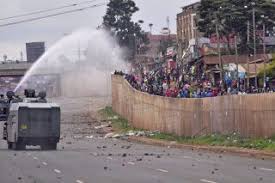Eleven dead and dozens injured in Kenya anti-government protests

What Happened on Saba Saba Day?
On July 7, 2025, thousands of Kenyans took to the streets to mark Saba Saba Day, a historic day that once symbolized the fight for democracy. This year, it turned deadly. Protesters clashed with police in major cities, including Nairobi, Eldoret, and Nakuru. At least 11 people died, and dozens were injured, including police officers and civilians.
Why Were People Protesting?
The immediate spark came after the death of Albert Ojwang, a popular blogger. Police arrested him in June, and he later died in custody. His death raised serious questions about police brutality. Many Kenyans, especially the youth, viewed it as the latest example of state violence. Protests began soon after, organized largely on TikTok, Instagram, and X (formerly Twitter).
However, anger had been building for months. People protested against:
- The rising cost of living
- Corruption in public offices
- Limited job opportunities
- Lack of police accountability
Police Response to the Protests
Police attempted to control the crowds with tear gas, water cannons, and, in some cases, live ammunition. In Nairobi, they blocked major roads and prevented protestors from reaching government buildings.
Eyewitnesses say officers used force even on peaceful protestors. Some reports also claim plainclothes officers and criminal gangs helped suppress the demonstrations. The Kenya Red Cross and local clinics treated many of the wounded.
Conflicting Reports on Casualties
According to Reuters, 11 people were confirmed dead. The Kenya National Commission on Human Rights (KNCHR) said 10 people died and 29 suffered injuries. The numbers may vary, but the message is clear: this was one of the deadliest days in recent memory.
Several video clips circulated online, showing people bleeding on the streets. Others showed terrified protestors running as police fired into the air.
The Government’s Stance
President William Ruto asked citizens to remain calm. He promised a review of the incidents but did not address the actions of the police. Critics argue that the government used excessive force instead of opening dialogue.
Authorities also blocked access to social media during parts of the protest and limited press coverage. This drew criticism from journalists and international observers, who accused the government of trying to silence dissent.
Youth at the Center of the Movement
The protests were led mostly by people under 30. Kenya’s Gen Z organized the marches online without a central leader. Their slogans—like “We are not our parents. We won’t be silenced.”—reflect a new political mindset.
Unlike past movements, this one feels more grassroots and less tied to traditional political parties. It shows that Kenya’s youth want real change and are ready to demand it.
How Does This Compare to Past Protests?
This isn’t the first major protest in recent years. In June 2024, demonstrations against the Finance Bill led to at least 8 deaths. The protests have now spread beyond tax issues to deeper problems within governance.
Since last year, over 20 people have died in protest-related incidents. Human rights groups have called for independent investigations, and activists demand reforms in law enforcement and governance.
What Comes Next?
Kenya stands at a turning point. The government can choose to listen to its people or continue using force. If authorities ignore the calls for justice and reform, more unrest could follow.
The Gen Z-led movement shows no signs of slowing down. With social media, they have tools to organize, communicate, and hold leaders accountable. Whether on the streets or online, these young Kenyans are pushing for a better future.






